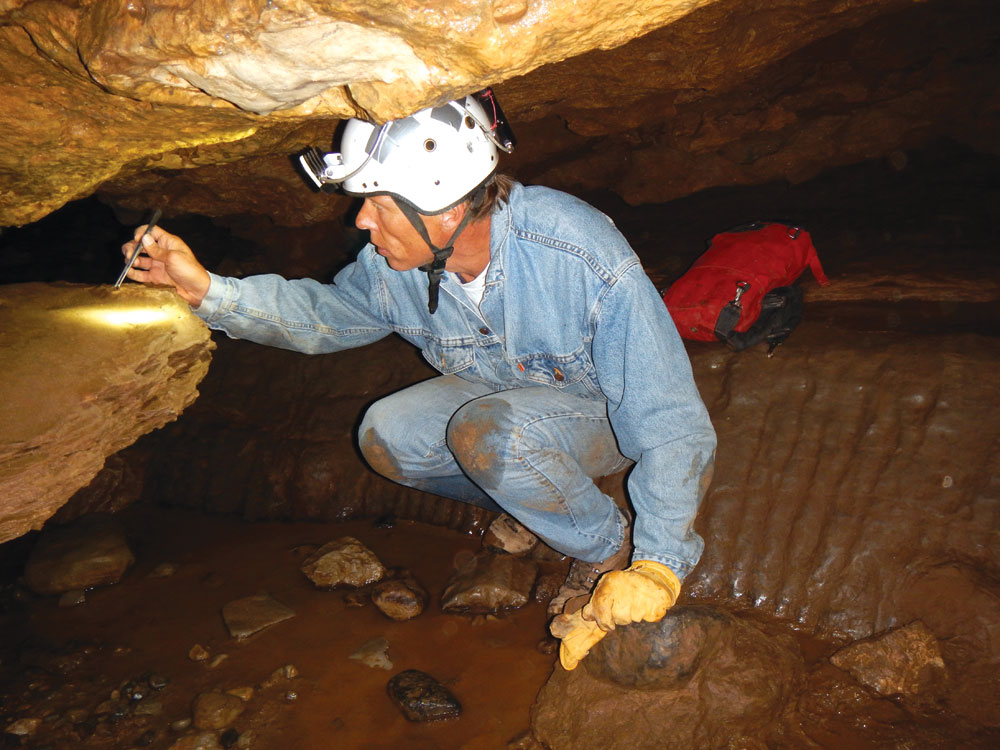
Dave Steinmann has been caving for 20 years and discovers about 10 species every year. Photos courtesy of DMNS
Dave Steinmann’s idea of fun is crawling around in a damp cave, looking for life.
“I look for anything alive: millipedes, tiny pseudo-scorpions, beetles and centipedes,” said Steinmann, a volunteer biologist for Denver’s Museum of Nature & Science.
Steinmann finds new, un-classified species—including a daddy longlegs that has been named for him. Sclerobunus steinmanni was found in 2008 in a rocky cave on City of Boulder Open Space and Mountain Parks land, behind the flatirons. “It takes a while after they’re found for them to be classified and named,” Steinmann said. “It’s an honor for me to have my contribution recognized like this.”
In 2009, Steinmann identified a second new daddy longlegs species in the Cave of the Winds in Manitou Springs, living deep underground in total darkness. This species was named Sclerobunus speoventus, derived from the Latin words for cave and wind. It lives in parts of the cave seldom visited by people.
“Every year I find about 10 more new species, right in our backyard,” said Steinmann, who has been caving for about 20 years. “Right within view of the city are new species, yet no one ever noticed. I’ve found more than 100 new invertebrate species in 50 Colorado caves. As far as I know, I’m the only person in Colorado researching cave life.”

Sclerobunus steinmanni is a new species of daddy longlegs discovered behind the flatirons in Boulder.
Steinmann goes caving with his wife, Debbie, and son Nathaniel, 12. “He’s smaller than we are, so if the space is tight we send him through to see what’s on the other side.”
Steinmann’s equipment is basic. “I take a good, really bright headlamp. I turn over rocks in moist areas. I collect with tweezers, or with a small, moist paintbrush for the tiny ones, and put them into a vial. Another way is to set a pitfall trap, a buried funnel with a jar at the bottom. You have to check it in a few days. I get a permit to collect from the cave’s owner or the Forest Service.”
Colorado caves can be difficult to access and also to get out of. “Sometimes access requires climbing a rope, and some caves are gated to protect bats. The longest cave I was in had 12 miles of passages. It’s completely dark and the Swiss cheese passageways connect, maze-like. It took 24 hours of constant moving to get in and out again.”
Steinmann said cavers can go hundreds of feet to a thousand feet under rock. “Passageways can be so narrow you have to let out your breath to squeeze through, or as large as a high school gym. The underground streams and waterfalls, the formations are amazing. It’s exciting to rappel into a pit and see a place no one else has ever been.”
Does he get scared?
“I’ve gotten stuck in a corkscrew passage I had to wiggle and claw to get out of. But I try not to have scary stuff.”
Steinmann brings the collected invertebrates back for study. “Some I send to experts around the world to identify them. I rely on the Denver Museum of Nature & Science for a lot.”
The Denver Museum of Nature & Science has added the two new daddy longlegs species to the Zoology Department’s arachnid collections.
“Daddy longlegs are not spiders,” said Paula Cushing, the museum’s curator of invertebrate zoology. She said they are in the arachnid class, which also includes spiders, scorpions, ticks and mites.
Sclerobunus steinmanni is orange and yellow, and very different looking from the daddy longlegs most familiar to people. Its pea-sized body connects spiked legs up to an inch long. DNA studies show this species evolved for millions of years while slowly adapting to the underground environment.
Because it evolved separately from its out-of-cave cousins, Sclerobunus steinmanni developed its own genetic differences and anatomical characteristics.
“It’s all about sex in arachnids,” said Cushing, an evolutionary biologist. “The genitalia of those inside the cave are such that they can’t mate with relatives outside the cave, only those inside. Cave systems are specific habitats. If a species can survive long enough, it can evolve separately from its relatives outside.”
The more we know about life forms on Earth, the better, according to Cushing. “We have one planet we know about that harbors life. We have one home and we should know more about the biodiversity here. We are part of the natural order and we don’t know how changes to the planet will impact our ability
to survive.”




0 Comments